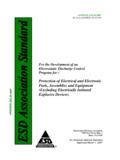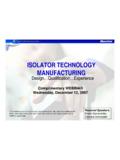Transcription of The Basics of Air Ionization for High-Technology ...
1 AIRIONIZATIONC ontrolling static charge is essential for maximizingyield, quality, and profit in High-Technology control enhances semiconductor production andhas become a necessity in the manufacture of hard disk drivesand flat-panel displays (FPDs).Failure to control static chargeleads to product losses from static-attracted particle contam-ination and from electrostatic discharge (ESD).Control programs to assist in mitigating static-charge prob-lems are available from several sources, among them the ESDA ssociation and Semiconductor Equipment and ,2 The primary method employed for dealingwith both conductive and static-dissipative objects including people is direct connection to ground to dissipatethe static products and work areas both may contain materialsthat are insulators.
2 When these insulators are part of the prod-uct itself, they cannot be eliminated. For example, High-Technology manufacturing makes use of oxide-coated siliconwafers,epoxy-packaged semiconductor devices, insulation oncomponent leads, glass epoxy printed circuit boards, and glasspanels for FPDs. In addition, materials such as Teflon, quartz,and many plastics necessary for resisting high temperatures orchemicals or providing cleanroom compatibility are has no effect on the levels of static charge on in-sulators. The only practical method for neutralizing staticcharge on most insulators is air ,4 The use of air ionizers is recommended in most publishedstatic-control programs, but those documents contain littleexplanation of the physics of the air Ionization process or ofthe effects of using ionizers in the manufacturing environ-ment.
3 Because marshalling air ions for static-control pur-poses is important in many industries, this article attempts to fill in the missing information for users of air Ions DefinedThe word ion, derived from a Greek verb suggesting motion,has the sense of a traveler. The term was first used to de-scribe the effects observed when electrical currents were passedthrough various solutions;molecules in the solutions woulddissociate and migrate that is, travel to electrodes of op-posite polarity. A theory advanced by the Swedish researcherS. A. Arrhenius that the migrating ions were electricallycharged atoms was substantiated by the later discovery of theelectron and its are defined as atoms or molecules that have lost orgained electrons.
4 (Electrons are the only easily available chargecarriers.) When an atom or molecule has an equal number ofelectrons and protons it is electrically balanced, or neutral. Ifan electron is lost, the atom or molecule becomes positivelycharged and is a positive ion. Gaining an electron makes it anegative is called an air ion, or a charged air molecule, is real-ly no such thing. Air is a mixture of gases, including nitrogen,oxygen, carbon dioxide, water vapor, and other trace gases,any one or more of which may be ionized. Sometimes a di-atomic gas molecule, such as nitrogen or oxygen, will gain orlose the electron. Sometimes it will be a more complex gassuch as carbon dioxide. In any case, when molecules of oneor more of the gases in air gain or lose electrons, the resultis conventionally called air ions.
5 Air ions differ from ions in The Basics of Air Ionizationfor high -TechnologyManufacturing ApplicationsARNOLDSTEINMANS everal techniques for changing the ambient air s burden of ions are effectivefor controlling static charge on insulating only practical methodfor neutralizing staticcharge on most insulatorsis air in that energy is needed for their normal, unfiltered air, air ions are molecular clustersconsisting of about 10 neutral gas molecules around a chargedoxygen, water, or nitrogen molecule. These are called smallair ions. Small air ions are relatively mobile and soon en-counter ions of the opposite polarity or a grounded surface,at which point they lose their charge and become neutralmolecules again.
6 Small air ions have a life span of a few secondsto a few minutes in clean the right conditions, these ions attach to particles orother large molecular clusters in the air, resulting in large airions. The relative proportion of small and large air ions pres-ent generally depends on the cleanliness of the air. Largequantities of particulate matter or aerosols in the air lead toa depletion of small air , any discussion of neutralizing static charge on in-sulators in a static-control program, as here, will deal primar-ily with the production and effects of small air Conductivity and Charge NeutralizationIf an ion is exposed to an electric field, it will move at aspeed dependent on the magnitude of the field and in a di-rection dependent on both the direction of the field and thepolarity of the ion (either of which may be positive or nega-tive).
7 The motion of ions in an electric field constitutes anelectric current whose density depends on the number of ionsin the air and the rate at which they move away from or towardthe source ofthe electric field. The relationship between thecurrent density and the electric field is known as the conduc-tivity ofthe conductivity may vary with the an object is charged, an electric field is established aroundit. The field strength will vary from point to point but is alwaysproportional to the charge. If the object is surrounded by airions of both polarities, a current carried by the ions of polar-ity opposite to its charge will flow toward the object. This neu-tralization current is proportional both to the charge on theobject and to the relevant conductivity of the surrounding simply, a charged object attracts ions of the ion exposed to an electric field Ewill move with anaverage drift velocity vproportional to E, that is,v=kE,(1)where kis the mobility of the air ions have mobilities in the range of s (centimeter2per volt-second).
8 This means that a smallair ion moves at a velocity of about 1 cm/sec when it is exposedto an electric field strength of 1 V/cm. It can be shown exper-imentally that the mobility of negative ions is approximately15% higher than the mobility of positive the air has a concentration nof positive ions with themobilitykand chargee,an electric field Ewill cause an elec-tric current to flow in the direction ofEwith the density E(2)The constant , which is equivalent to enk, is called thepositive conductivity of the air or, more precisely, the polarconductivity due to the positive ions will move in the opposite direction of thefield. However, Equation 2 can still be used to calculate currentdensity from negative ions when eis taken as the numericalvalue of the ion a body is given a charge qof either positive or negativepolarity, an electric field is established around the the body is surrounded by air containing air ions of bothpolarities, opposite-polarity air ions will flow toward it andions of the same polarity away from it.
9 While the field will varyfrom point to point in space, it is always proportional to movement of charge is an electric current. The currenttoward the body, carried by ions of polarity opposite to thatofqand known as the neutralization current, is proportionalto the charge and to the relevant opposite conductivity ofthe surrounding the air conductivity does not change, then the relativerate of charge neutralization is constant, and the charge willdecay exponentially with a time constant that depends on theair conductivity. In other words, given an initial charge q0,thecharge remaining at a later time is given byq=q0 t/ ,(3)where the time constant is equal to the permittivity of the air 0divided by the air conductivity.
10 = 0/ ;(4)thus,referring to Equation 3,q=q0 t(enk/ 0),(5)making the rate of charge neutralization proportional to theion , it is difficult to maintain constant air conduc-tivity. Many factors cause variations in the rate of charge decayThese factors include airborne-particle concentrations, de-pletion of ions in the vicinity of a charged object, the inho-mogeneity of ionized air, and nonuniform electric fields dueto irregularities in the charged object or nearby objects. Mak-ing corrections for all deviations from the simple case in orderto calculate the time constant is an impractical approach. It isgenerally more reasonable to measure the neutralizing prop-erties of an ionizer Air IonsIons are present naturally in the air, with positive ions usu-ally exceeding negative ions by a ratio of :1.








